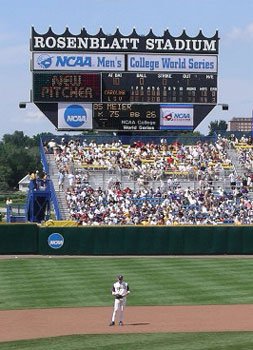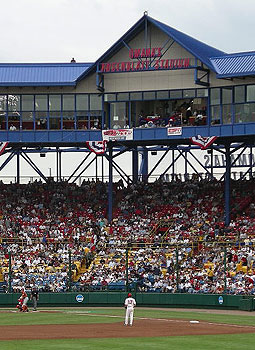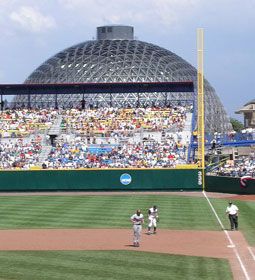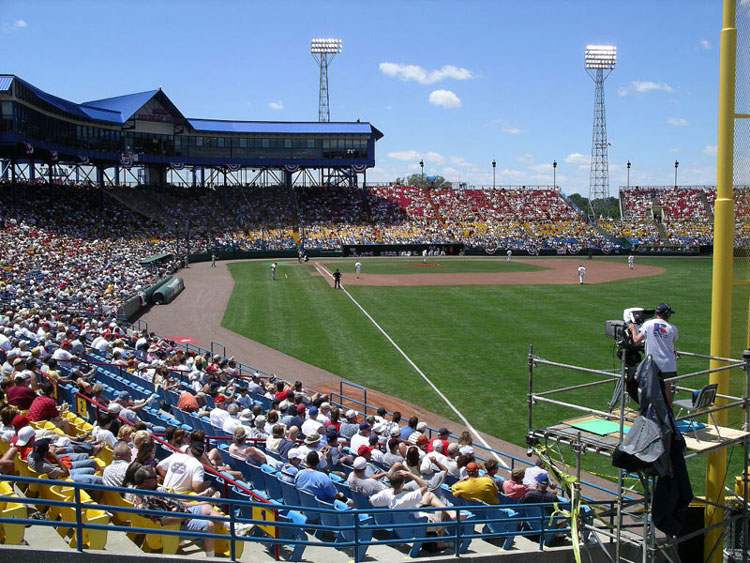
|
The College World Series I'm normally not a big fan of the ping and swing aluminum bats, but the College World Series is something every hardcore baseball fan should experience. It's truly the purest organized baseball atmosphere you'll ever encounter.
I'm normally not a big fan of the ping and swing aluminum bats, but the College World Series is something every hardcore baseball fan should experience. It's truly the purest organized baseball atmosphere you'll ever encounter.
Ballpark advertising is absent during the 10-day tournament, so the outfield wall and scoreboard contains only NCAA logos. The NCAA doesn't allow the theme music that normally is played for each hitter. Ads from sponsors are banned inside the stadium, and the overall lack of pumped in noise from the loud speakers makes for a very subdued atmosphere. It's funny how I've become used to all the promotions, ads, and other noise encountered at the ballpark, and when those things are absent it actually felt initially awkward, as if something was missing. The focus here is on baseball, and that's it! I found myself thinking 'So this is what baseball used to be like!' Large crowds attend most of the games, but the majority of fans are neutral locals. Although all of the games "sell out" there are plenty of seats to be found, even if you only have the $6 general admission tickets for the outfield bleachers. There's a festive atmosphere outside the ballpark, with numerous vendors set up across the street selling food and souvenirs. The official Fan Fest occupies a large amount of space near the stadium's main concourse, where former Major League players sign autographs after games. A trip to Rosenblatt in June is one of those pilgrimages like Fenway, Wrigley, and the Rickwood Classic that should be experienced by all. If they got rid of the aluminum bats, nothing would taint the CWS.
College World Series HistoryThe first ever College World Series was played at Hyames Field in Kalamazoo, MI in 1947 and was simply a best of three series between California and Yale. Cal swept the series in two games to become the first CWS champion. The CWS returned to Kalamazoo in 1948 (this time Yale was beaten by USC), before moving to Wichita, KS in 1949, where four teams played in the tournament. Two permanent changes occurred in 1950, when the CWS field expanded to 8 teams and the location was switched to Omaha. Total attendance at Omaha Municipal Stadium, since renamed Rosenblatt Stadium, was just 17,805, but a tradition was born. Almost sixty years later, the College World Series is still played in Omaha and no other city is more closely identified with hosting a championship event.
Rosenblatt Stadium It cost $770,000 to build Omaha Municipal Stadium, which opened in 1948 with a seating capacity of 10,000. Original construction plans called for a brick exterior, but that was scaled back to concrete to save money. Even so, construction of the ballpark cost $290,000 more than planned.
It cost $770,000 to build Omaha Municipal Stadium, which opened in 1948 with a seating capacity of 10,000. Original construction plans called for a brick exterior, but that was scaled back to concrete to save money. Even so, construction of the ballpark cost $290,000 more than planned.
Two years after opening, Omaha attracted the College World Series to their new stadium and the CWS has been married to Rosenblatt ever since. Over the years the CWS has become a major event, and the city of Omaha has spent over $35 million in upgrades to keep the stadium up to championship standards. Total seating is now 23,100, with 17,700 seats located in the grandstand and View Club, while another 5,400 patrons occupy the outfield bleacher seats, which are sold as General Admission. The ballpark's design is fairly simple. It's signature press box, held up by a lattice work of exposed blue steel and recognizable to millions of fans from ESPN's broadcasts, beams "Omaha's Rosenblatt Stadium" in neon red. Two other things that stand out are the large glassed-in auxiliary press box behind the first base grandstand and the raised narrow walkway that connects the right field bleachers to the first base grandstand. Rosenblatt Stadium has one main scoreboard in left field and a pair of smaller video boards in center field. It's one of a handful of stadiums that still uses live music instead of prerecorded music. The ballpark does have a full-time tenant: The Omaha Royals, the Triple-A affiliate of the Kansas City Royals, have played here since their inception in 1969. Capacity is limited to 9,441 for O-Royals games.
Who was Rosenblatt?Johnny Rosenblatt was instrumental in the construction of the ballpark which now bears his name. Rosenblatt was the mayor of Omaha from 1954-1961, but before entering a life of public service he played amateur and semipro baseball. He was the person most responsible for getting the stadium built, as he pushed for its construction after personally locating a hilltop site. The ballpark was renamed in his honor in 1964. Rosenblatt died in 1979.
Ballpark LocationRosenblatt Stadium is located about one minute off of I-80, along 13th Street, in a residential neighborhood in Omaha, approximately three miles south of downtown. The Missouri River and Iowa state line are located just a mile from the ballpark, which is easy to see from the Interstate thanks to its elevated hilltop location.
Parking and TicketsDuring the CWS the parking lots around the stadium are reserved parking only and not available to the general public. Many local homeowners and businesses offer parking at a high rate, but there's also some places where you can park for free. We found one such place, in a large grassy area next to I-80, and parked there free of charge for four consecutive days. Advanced reserved and box seats are sold out, but up to 1,000 reserved seat tickets are made available on the day of the game (for each game) at the Rosenblatt box office, beginning at 10 a.m. General Admission ticket books offer an inexpensive way to watch the CWS. A book of 10 tickets costs only $60 (2007 pricing) and a GA ticket can be used for any game. Seating is limited to the outfield bleachers, available on a first-come, first-served basis to 5,400 people. No session date or seat number is printed on the ticket and the best seats in the bleachers go to those who arrive the earliest. Although you're not guaranteed admission with a GA seat you'll almost always get in the ballpark. It's important to note that the later you arrive at Rosenblatt the longer you'll have to wait at the GA entrance line in left field.
The Future of the CWS in OmahaCollege World Series of Omaha, Inc., the local non-profit organizing body, determined in 2005 that it would cost at least $25 million in future improvements to Rosenblatt Stadium to ensure it would continue to be a viable venue to host the NCAA baseball championship. The NCAA suggested an alternative: build a new stadium. So the city developed plans for a $50 million stadium in downtown Omaha. The new stadium would have 9,000 permanent seats, with the ability to expand to 25,000 for the CWS. Whether the city would go forward with building a new stadium depends on the NCAA. Omaha's current contract to host the CWS runs through 2010, and the city wants at least a 10-year extension for them to seriously consider building a new ballpark. The NCAA generally grants extensions in five-year increments.
Omaha to Replace Rosenblatt in 2011On June 10, 2008 the Omaha City Council officially approved a contract to build a new $140 million downtown ballpark after the NCAA agreed to a 25-year extension with the city to hold the College World Series there. Rosenblatt Stadium, home to the CWS since 1950, will be torn down after the 2010 season, with its land slated to become a parking lot for Omaha's zoo. The new ballpark will be built next to the Qwest Center and open in 2011.
Footnotes: Facts and FiguresOver six million fans have attended CWS games at Rosenblatt Stadium. The six million milestone was accomplished on June 16, 2006. A record 310,609 fans attended the 2006 College World Series. A paid record crowd of 30,335 attended the games on June 21, 2006 between North Carolina/Cal State Fullerton and Oregon State/Rice. In the mid-1970s overflow crowds sat in foul territory down the first and third base lines, plus on the warning track, where fans held a yellow rope serving as a barrier between themselves and the field of play. Any ball hit into the warning track throng was ruled a ground-rule double. Rosenblatt Stadium was designed by Leo Daly Jr. and built by Peter Kiewit Sons' Construction Company.
Pictures
| |||||||||||||||||||||

 The ballpark is located next door to the Henry Doorly Zoo and you can't miss the zoo's signature exhibit, The Desert Dome, looming beyond right field. The dome is 13 stories tall (137 feet high), making it the world's largest indoor desert, and contains plant and animal life from three deserts around the world. The Desert Dome opened in April 2002 and has been a part of Rosenblatt's landscape ever since.
The ballpark is located next door to the Henry Doorly Zoo and you can't miss the zoo's signature exhibit, The Desert Dome, looming beyond right field. The dome is 13 stories tall (137 feet high), making it the world's largest indoor desert, and contains plant and animal life from three deserts around the world. The Desert Dome opened in April 2002 and has been a part of Rosenblatt's landscape ever since.




